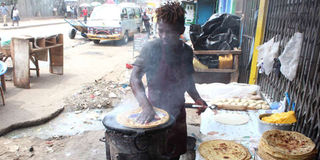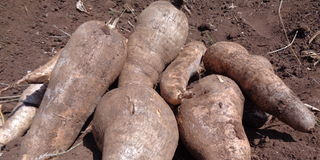
A man prepares chapati near flowing untreated sewage at 11th Street in Eastleigh Section One, Nairobi.
Imagine a time when chapatis were a luxury, a symbol of opulence, reserved for celebrations and the tables of the wealthy. Fast forward to today and you'll find these humble flatbreads sizzling on griddles in low-income settlements, capturing hearts and appetites alike.
The popularity of chapati as a staple food among low-income families is on the rise, largely due to its affordability and accessibility. In contrast to its earlier status as a luxury food, chapati has become a budget-friendly option for many households across settlements.
"Chapati has become our daily bread, it’s affordable, filling, and readily available. I used to see chapati as something special, something reserved for celebrations. Now, it's a part of our daily meals,” chuckled Jane Muthoni, a resident of Mathare.

Surprisingly, people from more affluent backgrounds are increasingly turning to traditional staples such as arrowroot and sweet potato.
Not so long ago, staples such as arrowroot and sweet potatoes dominated the plates of people living in low-income settlements.
Not only were these items affordable, but they were also seen as a symbol of sustenance for those with limited means. However, the narrative has changed significantly and chapati has become the preferred choice for families facing financial constraints.

The popularity of chapati as a staple food among low-income families is on the rise, largely due to its affordability and accessibility. In contrast to its earlier status as a luxury food, chapati has become a budget-friendly option for many households across settlements.
Walking through the narrow alleys of Githurai, Mathare and Mukuru Kwa Njenga, you will come across a carnival of vendors every 10 minutes or so, displaying their chapatis, rock-hard mandazis and, if that's not your thing, a sizzling array of chips, crispy viazi karai and delicious samosas to tempt your taste buds! What was once a rare treat has now become a daily staple for many families in these low-income areas.
In Mathare, the sizzling sound of chapati being cooked on makeshift stoves fills the air. Vendors have set up shop to prepare and sell these flatbreads for a modest price, with most units selling for as little as Sh10.
Amidst the fragrant cloud of cooking chapati, locals eagerly line up to purchase these warm and satisfying delicacies.
Local vendors reveal that they can make up to 40 chapatis from a single packet of wheat flour, making it an economical choice for both vendors and consumers.
Affordability and accessibility
The affordability and accessibility of chapati have made it a household favourite, providing an alternative that won't break the bank.
John Kamwere, a chapati vendor in Mathare, explains that his production varies from 32 to 40 pieces of chapati per packet of flour, and he sells each chapati for between Sh10 and Sh15. The prices are affected by the fluctuating cost of flour. However, he buys the flour in bulk during sales.
“Currently, I sell chapati at Sh15, which means I make a profit of Sh404 considering that a packet is Sh196. I used to sell them at Sh20 when the prices were higher, and I've noticed that people still buy them. I want to emphasise the cost-effectiveness of chapati for dinner, particularly when compared to spending Sh60 on vegetables. People prefer chapati because it's more affordable and convenient, especially when you take into account the additional costs of ugali flour and oil needed for preparing a meal,” said Kamwere.
Carrefour supermarkets
At Carrefour supermarkets in Kenya, prices for various wheat flour products are as follows: Unga All Purpose Fortified Wheat Flour 2kg is priced at Sh193, Ajab All Purpose Flour 2kg is available at Sh194, Unga Exe Chapati Fortified Wheat Flour 2kg is offered at Sh196 and Exe Unga Mandazi Fortified Wheat Flour 2kg is priced at Sh198.
The shift in food preferences is not limited to low-income settlements. Surprisingly, people from more affluent backgrounds are increasingly turning to traditional staples such as arrowroot and sweet potato.
The once humble root vegetables are now perceived as healthier alternatives and are gaining popularity among those with the means to explore diverse culinary options.
“Arrowroots, sweet potatoes, and cassava are scarce nowadays, mainly due to their high prices. Although we used to cook them before, the high cost has led us to opt for chapati instead,” said Kamwere.

Cassava.
Judah Kilonzo, a resident of Zimmerman, said: “Back in 2019, I used to buy arrow roots for my breakfast at work. However, that routine has changed because the vendor switched to selling mandazi, viazi karai, and chips.”
Increased prices
She mentioned that due to increased prices, customers found it challenging to purchase her previous products, prompting her decision to shift focus.
At the bustling Githurai market, the availability of sweet potatoes, arrowroot and cassava comes at a price.
Sweet potatoes sell for Sh60 a bunch, while three raw pieces of arrowroot sell for Sh200.
Cassava, on the other hand, ranges between Sh80 and Sh100, reflecting the complex interplay of market forces that shape the accessibility and affordability of these staple foods.
According to the Kenya National Bureau of Statistics' annual consumer price index, prices of basic commodities have risen steadily over the past year.
In the food sector alone, nine out of 12 basic commodities have increased in price, affecting the daily lives of ordinary citizens.
But as people increasingly rely on wheat-based diets, nutritionists are sounding the alarm about potential health risks.
Rose Joy Etale, a clinical nutritionist, highlights the issue of hidden hunger, a condition where people are getting enough calories but lack essential micronutrients such as vitamins and minerals.
"Wheat, while providing a feeling of fullness, is not adequately fortified with essential vitamins and minerals. This can lead to a deficiency in crucial micronutrients, setting the stage for hidden hunger. Regular consumption of wheat-based meals, particularly chapati, may result in a significant shortfall of vital nutrients,” she said.
In addition, the risk of chronic disease and obesity is a growing concern. She highlighted the importance of a balanced diet for growing children and the potential long-term consequences of a diet lacking in essential nutrients.
"When individuals opt for refined wheat and indulge in fatty foods such as chips, the nutritional value diminishes significantly. This can contribute to health issues like obesity and other chronic diseases,” she noted.
The impact of a wheat-based diet extends beyond adults to children in households where chapati is a staple food.
"Children relying heavily on chapati without adequate protein sources may experience malnutrition, hindering their growth and development,” Etale said.






